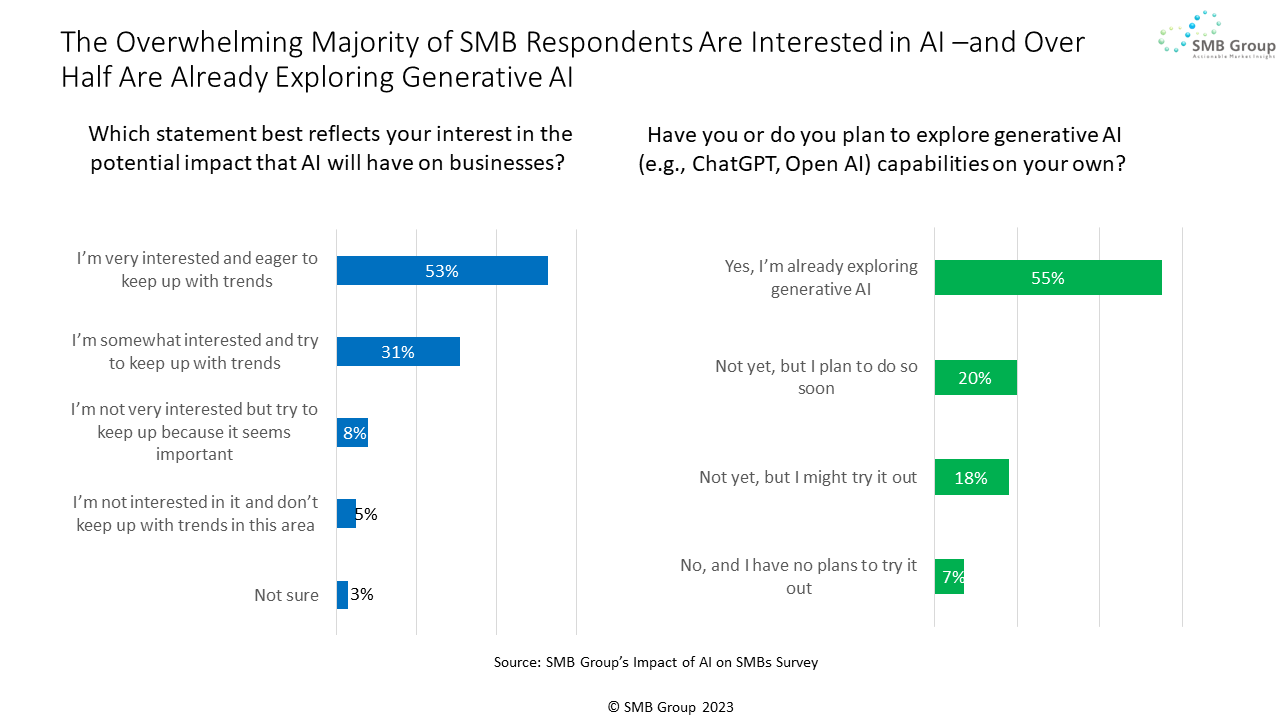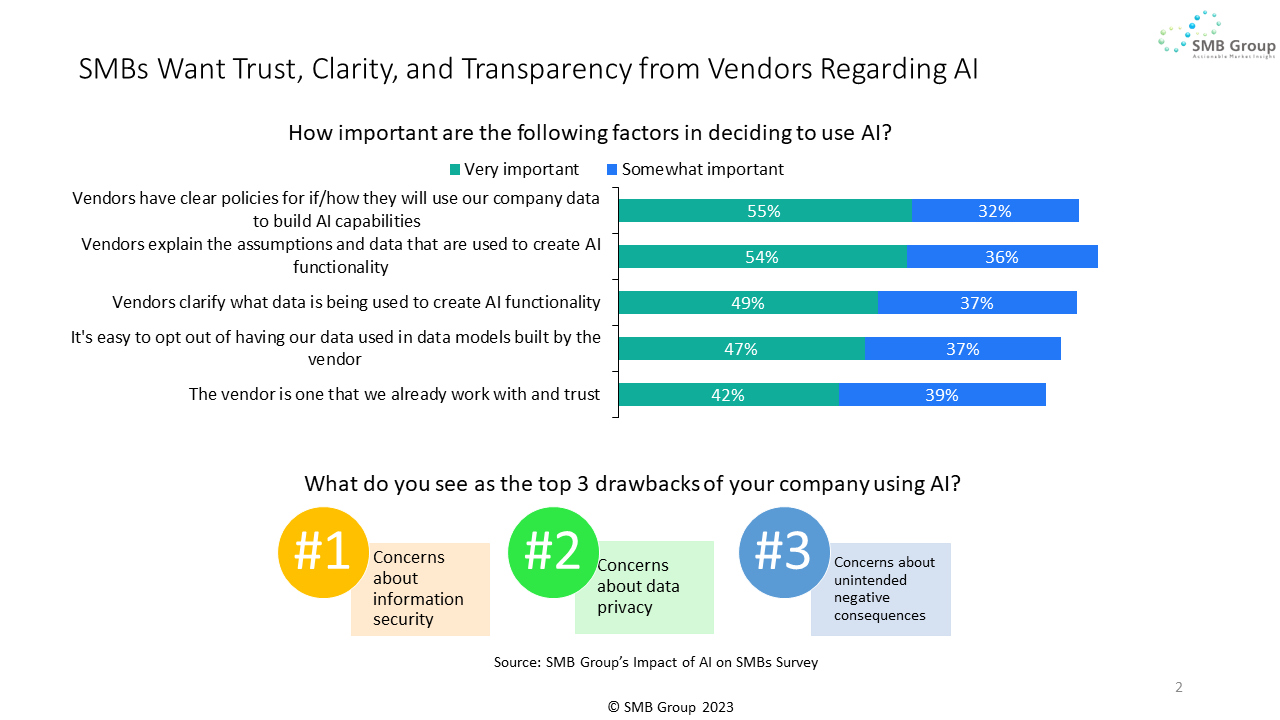HubSpot’s Inbound 2023 conference was held last week in Boston. Like seemingly every other tech event this year, the theme of Inbound was AI — specifically, how businesses can use AI to better connect to and engage with their customers. In this blog, I delve into HubSpot’s AI strategy and offerings, as discussed in the keynote address at the conference.
Generative AI Ushers in the Intelligence Age
Before diving into HubSpot’s AI strategy, it’s crucial to remember that AI isn’t a new concept; it’s been evolving for decades. AI technologies can help businesses process vast amounts of data, provide actionable insights, and enable personalized interactions. Many business application vendors, including HubSpot, have been using different AI technologies to help their customers predict market trends and streamline business functions for many years
However, the recent rise of generative AI is turbo-charging interest and appetite in AI. Generative uses a conversational interface, so almost anyone can easily query it and explore different ways to use it. In addition, unlike traditional AI, generative AI can create entirely new things, from data reports to images to songs.
According to HubSpot, generative AI will usher in the intelligence age and revolutionize how knowledge and creative work get done by supercharging various aspects of the business.
Using AI to Drive Customer Connections
HubSpot’s research reveals that companies that focus on building strong customer connections are more likely to grow their businesses than other companies.
As Yamini Rangan, HubSpot’s CEO noted, as AI becomes more ubiquitous, it is changing customer expectations across each stage of the buying journey:
- Discovery: The discovery phase is shifting from search to social. Buyers want to discover new products and services before they even search, leading 44% of buyers to use social media for discovery.
- Consideration: People want more efficient ways to learn about new products and services. Instead of clicking through websites to find information, they want access to one-on-one chat conversations.
- Buying: Customers increasingly expect vendors to provide personalized insights instead of generalized information. They also expect businesses to remember their experiences with the brand in context, across all previous interactions.
- Use: HubSpot noted that 98% of customers find their service experiences frustrating. Instead of reactive help when a problem arises, they want vendors to deliver proactive advice and action to solve problems.
HubSpot’s AI Advice for Customers: Just Do It
According to SMB Group’s 2023 Impact of AI on SMBs survey, 84% of SMB respondents say they’re interested in using AI for business purposes. 55% are already exploring generative AI on their own, and 20% are planning to do so.
However, as HubSpot execs acknowledged, although interest is high, many SMBs are unsure about how to use generative AI.
While there’s no established framework for generative AI in customer operations yet, HubSpot issued a simple directive to customers: Don’t stand still, just start using AI now. Although we’re in the early days of the technology, and there’s no magic formula for success, HubSpot recommends customers start by focusing on the following.
- Bots: Start by deploying AI-powered bots that can answer common customer questions. HubSpot’s AI bots have already answered 78% of inquiries effectively.
- Content Creation: Use AI to refresh and optimize content.
- Sales Efficiency: Equip sales reps with AI-driven tools and insights to improve customer connections.
- Customer Engagement: Leverage AI to encourage customer engagement by providing a more personalized experience to customers.
HubSpot’s AI Strategy and Solutions
At Inbound, HubSpot introduced HubSpot AI, powered by Smart CRM, which combines ChatGPT with customers’ existing HubSpot data to provide content, context, and information for more tailored and accurate results.
Some notable AI-powered features introduced by HubSpot include:
- Image creation for Content Assistant, which launched six months ago, and has already helped customers to create over one million pieces of content. At Inbound, HubSpot announced that a new beta version of Content Assistant can also create images based on user prompts, either from scratch or based on user content.
- Campaign Assistant, to quickly create marketing campaigns. By answering a few questions, users can create complete campaigns, including forms, landing pages, emails, calls to action, ads, and more across different platforms and channels. Notably, this service is completely free to use – even if you’re not a HubSpot customer.
- Website Assistant enables users to build a website with just a few prompts.
- AI Chatbots, now in private beta in Service Hub, add AI chatbots that read everything on a company’s website and answer questions as they come in.
- Updates to Sales Hub use AI to streamline the prospecting experience by providing context on all interactions for leads; and new prospect reporting to more easily see what’s driving connections and what’s not.
- Enhanced sales forecasting with AI, now in private beta, to improve projections to up to 95% accuracy.
- Reporting Assistant uses generative AI to make it easier for users to ask questions, get information, and create charts.
- New proactive advice capabilities for Service Hub use AI to craft messages, recap conversations, and assign, triage, and respond to issues.
- Smart CRM provides extensions for users to build unique layouts and workspaces geared to the needs of each team.
HubSpot also announced a new partnership with LinkedIn that will synch data between Sales Hub and LinkedIn Navigator is in the works, and has added professional invoice capabilities, automated billing, and connections to accounting and payments software to streamline the B2B payments process.
The Future of Generative AI
Dharmesh Shah, HubSpot’s co-founder and CTO, is passionate about AI – and recounted the story of how he “fell in love with AI” in 2020 after a “mind-expanding call” with AI startup OpenAI’s Sam Altman. Subsequently, he used ChatGPT API to build a chat app and discovered it could create content for both humans and machines. Instead of building software apps with traditional point, click, drag, drop methods, generative AI interfaces can enable people to just type in a prompt to build code.
This capability, according to Shah, will make generative AI the most popular programming language, especially among the younger generation growing up with it – and democratize technology. While today, large language models (LLMs) are static, Shah posited that they will become dynamic and augmented by real-time data. In his view, AI will evolve to become multi-modal, agent-driven, and tailored to specific users’ needs.
Shah also shared his thoughts about whether AI will take away jobs. His belief is that yes, AI will take your job – but give you a better one, with less drudgery and more creativity, helping you do whatever you do better.
Shah briefly mentioned issues with AI, such as hallucinations, and the potential for it to create inappropriate, biased or harmful responses, and mentioned the importance of keeping humans in the loop to check outputs and build trust.
Perspective
Although most SMBs want to take advantage of AI, few have the resources and expertise to integrate AI capabilities into their operations on their own. So, it’s not surprising that two-thirds of respondents in SMB Group’s 2023 Impact of AI on SMBs believe that it’s important for technology vendors to incorporate AI functionality into their solutions. Just 11% view this as unimportant.
As also indicated in our survey, many SMBs also expect their technology vendors to provide them with guidance to help them use AI effectively and safely.
At Inbound, HubSpot painted a clear picture of its strategy to provide its SMB customers with accessible, turnkey AI capabilities embedded in its solutions, and some preliminary guidance to encourage them to start using it.
HubSpot will need to build out the educational part of its strategy and clarify its policies and practices to minimize any negative outcomes. As noted in our survey, SMBs ranked concerns about data security, privacy, and “unintended negative consequences” as the top three drawbacks of AI. They want vendors to provide clear information about where data comes from, how data is used, and the assumptions they use to create AI functionality.
In addition, while the majority of SMBs won’t need to become AI technology experts, they will need vendors to help them develop AI skills and capabilities to use AI effectively and safely.
HubSpot – and other vendors – need to transparently communicate data sources, usage, and AI assumptions, and help SMBs develop the necessary AI skills to make informed decisions and maximize their AI investments.
© SMB Group 2023


